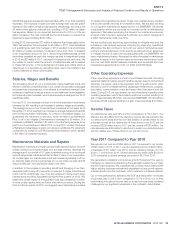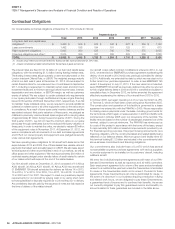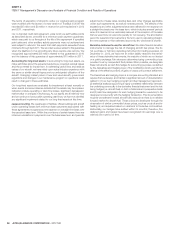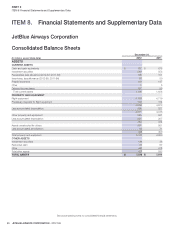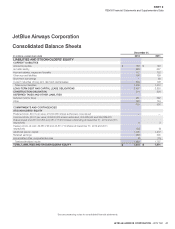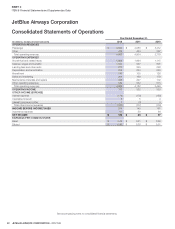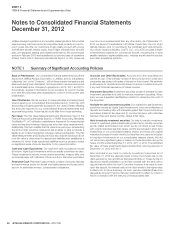JetBlue Airlines 2012 Annual Report Download - page 42
Download and view the complete annual report
Please find page 42 of the 2012 JetBlue Airlines annual report below. You can navigate through the pages in the report by either clicking on the pages listed below, or by using the keyword search tool below to find specific information within the annual report.JETBLUE AIRWAYS CORPORATION-2012 10K38
PART II
ITEM7Management’s Discussion and Analysis of Financial Condition and Results of Operations
The terms of expiration of all points under our original loyalty program
were modifi ed with the launch of a new version of TrueBlue in 2009. We
recorded $5 million and $3 million in revenue for point expirations in 2012
and 2011, respectively.
Our co-branded credit card agreement, under which we sell TrueBlue points
as described above, provided for a minimum cash payment guarantee,
which was paid to us throughout the life of the agreement if specifi ed
point sales and other ancillary activity payments were not achieved and
was subject to refund in the event that cash payments exceeded future
minimums through April 2011. We recorded revenue related to this guarantee
when the likelihood of us providing any future service was remote. We
recognized approximately $5 million related to this guarantee in 2010
and the balance of this guarantee of approximately $10 million in 2011.
Accounting for long-lived assets. In accounting for long-lived assets, we
make estimates about the expected useful lives, projected residual values
and the potential for impairment. In estimating useful lives and residual
values of our aircraft, we have relied upon actual industry experience with
the same or similar aircraft types and our anticipated utilization of the
aircraft. Changing market prices of new and used aircraft, government
regulations and changes in our maintenance program or operations could
result in changes to these estimates.
Our long-lived assets are evaluated for impairment at least annually or
when events and circumstances indicate that the assets may be impaired.
Indicators include operating or cash fl ow losses, signifi cant decreases in
market value or changes in technology. As our assets are all relatively new
and we continue to have positive operating cash fl ows, we have not identifi ed
any signifi cant impairment related to our long-lived assets at this time.
Lease accounting. We operate airport facilities, offi ces buildings and aircraft
under operating leases with minimum lease payments associated with
these agreements recognized as rent expense on a straight-line basis over
the expected lease term. Within the provisions of certain leases there are
minimum escalations in payments over the base lease term and periodic
adjustments of lease rates, landing fees, and other charges applicable
under such agreements, as well as renewal periods. The effects of the
escalations and other adjustments have been refl ected in rent expense on
a straight-line basis over the lease term, which includes renewal periods
when it is deemed to be reasonably assured at the inception of the lease
that we would incur an economic penalty for not renewing. The amortization
period for leasehold improvements is the term used in calculating straight-
line rent expense or their estimated economic life, whichever is shorter.
Derivative instruments used for aircraft fuel. We utilize fi nancial derivative
instruments to manage the risk of changing aircraft fuel prices. We do
not purchase or hold any derivative instrument for trading purposes. At
December31, 2012, we had a net $1 million liability related to the net fair
value of these derivative instruments; the majority of which are not traded
on a public exchange. Fair values are determined using commodity prices
provided to us by independent third parties. When possible, we designate
these instruments as cash fl ow hedges for accounting purposes, as defi ned
by the Derivatives and Hedging topic of the Codifi cation which permits the
deferral of the effective portions of gains or losses until contract settlement.
The Derivatives and Hedging topic is a complex accounting standard and
requires that we develop and maintain a signifi cant amount of documentation
related to (1)our fuel hedging program and fuel management approach,
(2)statistical analysis supporting a highly correlated relationship between
the underlying commodity in the derivative fi nancial instrument and the risk
being hedged (i.e. aircraft fuel) on both a historical and prospective basis
and (3)cash fl ow designation for each hedging transaction executed, to be
developed concurrently with the hedging transaction. This documentation
requires we estimate forward aircraft fuel prices since there is no reliable
forward market for aircraft fuel. These prices are developed through the
observation of similar commodity futures prices, such as crude oil and/or
heating oil, and adjusted based on variations to those like commodities.
Historically, our hedges have settled within 24 months; therefore, the
deferred gains and losses have been recognized into earnings over a
relatively short period of time.



